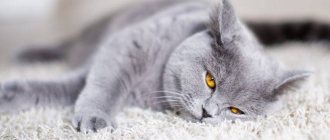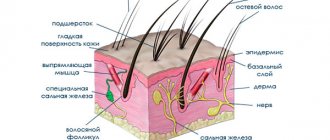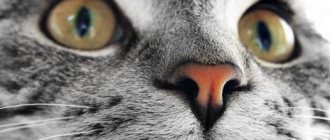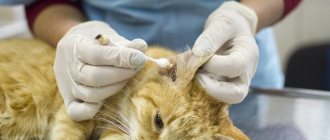Cats use their ears to regulate their body temperature.
During the warm season, vasodilation occurs in the cat’s body. This means that the blood vessels dilate, pumping blood faster and stronger. This increases the cat's body temperature, and excess heat escapes through the ears.
In winter, vasoconstriction occurs in the cat’s body. Blood vessels constrict, retaining heat in the body. When a cat curls up into a ball, it protects its ears by preventing heat from escaping.
Check your cat's ears several times throughout the day. If their temperature does not change, then medical intervention may be required.
Common reasons why cats may have hot ears:
- direct exposure to a heat source;
- accumulation of earwax;
- elevated temperature;
- ear infections caused by parasites;
- polyps, cysts and tumors;
- allergies;
- stress.
Don't panic right away if you discover that your cat has hot ears. These may be temperature changes inherent to it.
Warm
Cats love to rest in warm places, especially near radiators. In such cases, the ears will be the first part of the body to heat up. The cat is also able to regulate its own temperature. Once the heat source gets too hot, the cat will go elsewhere and its ears will cool down automatically.
The only exception is direct sunlight. Cats are big fans of the sun, so you need to monitor their time outdoors. A cat that spends a lot of time in the sun is at risk of developing skin cancer.
It is safer to let your cat bask in the sun indoors. Let your cat snooze on the windowsill, soaking up the sun's rays through the protective layer of glass.
A cat's nose as an indicator of well-being
The main function of a cat's nose is olfactory. Thanks to numerous (almost 20 times more than in humans) receptors, it helps completely blind kittens to freely navigate in space from birth. Babies deprived of sight and hearing always find their mother by reacting to surrounding smells.
The nasal sinuses are separated by a cartilaginous septum, and immediately behind them are the ethmoidal conchae. All odors entering this section are transmitted by receptors directly to the brain, which identifies the sniffed object or subject. The nasal bones of flat-faced breeds are deformed, making it more difficult for them to recognize odors and have a harder time breathing.
In addition to the olfactory, it is important to note the protective and tactile functions. The inhaled air is filtered inside the sinuses to remove dust and microorganisms and warms up to a comfortable temperature. The tactile function is performed by the lobe. This is what cats use to determine the temperature of food.
For the owner of a mustachioed pet, the latest function remains important, allowing you to assess your well-being without undergoing tests. If the animal is healthy, then its lobe:
- a little shiny;
- cool;
- wet;
- has no crusts or scales.
Humidity is achieved thanks to a special secretion secreted by the mucous membranes. It creates a protective film that protects the cat from the adverse effects of external factors, and helps to retain molecules of foreign substances to recognize their odors. Also, the wetness of the nose is associated with frequent licking, characteristic of the cat family.
Fever
When a cat's ears are hot, it's tempting to immediately assume that she has a fever. This cannot be ruled out, but it is not necessarily always true. Cats can withstand a wide range of temperatures. Their immune system is constantly fighting viruses. This can lead to temporary temperature spikes bordering on fever. As the cat's body clears the virus, the ear temperature returns to normal.
If your cat's ears are constantly hot, the fever is not going away. There are many explanations for this, including:
- upper respiratory tract infections;
- bacterial infections (often caused by bites from other cats);
- heatstroke;
- reactions and side effects (from medications and vaccines);
- consumption of toxins;
- chronic disease (for example, arthritis).
If your cat has discharge from the nose and eyes, it is an infection that can be treated with regular antibiotics. The reaction after vaccination lasts a couple of minutes. If your cat reacts to medications, you should contact your veterinarian.
If your pet has heatstroke, he will be dehydrated, lethargic, and may experience seizures.
If a cat has hot not only ears, but also a nose, then there may be serious health problems.
- The cat's body fights a viral infection
- Various intestinal disorders
- Cold
- Ear mites (symptoms and treatment we discussed above)
- There are a lot of infectious diseases that occur hidden and can only be identified by a specialist.
- External and internal inflammatory processes
- The cat may be injured, but if the damage is internal, you will not be able to determine it yourself
How to determine if your pet is sick
The cat has become lethargic, stopped eating, does not go to the toilet (or tries but fails), sneezes, and has a depressed and apathetic state. By measuring the temperature, you can determine whether there are inflammatory processes in the animal’s body.
What to do?
If your pet's behavior has changed dramatically. Visit a veterinarian, or make a house call, if possible. Don't let your pet's condition take its course. Help him and he will be grateful to you.
Ear infections
There are two main types of ear infections in cats.
Otitis interna is an infection of the inner ear, usually caused by inflammation.
Otitis externa , as the name suggests, affects the outer ear. This usually occurs around the eardrum.
The symptoms of both infections are the same. These include:
- strong heating of the ear;
- redness and swelling;
- ear discharge (yellow, black, or brown);
- unpleasant odor from the ear;
- temporary deafness or hearing loss;
- poor balance and uncoordinated gait.
Ear infections can be painful. Fortunately, they are easy to treat, although the infection can cause secondary health problems. Minimize the risk of ear infections by keeping your cat indoors and cleaning her ears regularly.
To treat an ear infection, start with over-the-counter ear drops. This may eliminate the need to visit a veterinarian. If the symptoms go away, your cat is fine. If the infection has spread, antibiotics prescribed by a specialist will be required.
Treatment
There is no single treatment regimen for ear inflammation in cats. Therapy for diseases is chosen in accordance with the identified pathology.
Otitis, infectious, fungal diseases, otodectosis are treated after consultation with a veterinarian, medications are given to the animal as prescribed and under the supervision of a specialist.
Self-medication is excluded
Only a veterinarian can accurately diagnose and identify pathology .
Self-medication is fraught, the situation may worsen, a secondary infection will develop, the animal will lose hearing or die, experiencing severe pain.
Examination by a veterinarian
At the clinic, the cat will be examined, a history of the disease will be collected, the owner will be interviewed, and swabs will be taken from the ear.
If necessary, the animal will be prescribed a general blood test, ultrasound or x-ray.
Prescribed procedures
To begin with, the auricle is cleaned of contents with veterinary ear lotions. Special products dissolve dirt and exudate.
Depending on the test results, a drug is chosen.
The drug is injected into the ear after it is completely cleansed. The drops are given strictly on schedule, for as many days as prescribed by the veterinarian.
The animal may need antipruritic medications, anti-allergy medications, antiparasitic, antifungal medications, and antibiotics.
Ear parasites
A cat's ears can harbor fleas and ear mites, which feed on wax and cause ear inflammation.
The appearance of ear mites is accompanied by the following symptoms:
- hot ears;
- brown discharge from the ear canal that resembles coffee grounds;
- itching in the ears and surrounding areas;
- cracked skin in the ears;
- shaking and tilting of the head.
The mites themselves do not affect your pet's health, but if left untreated they will multiply and cause increased stress levels. Treatment involves simple ear cleaning. You will need to use a special, prescribed cleaner.
Polyps, cysts and tumors
Sometimes hot ears in cats can be caused by a tumor. Check your cat's inner ear with a flashlight. Not all formations require emergency medical attention. Sometimes they are completely benign. However, some tumors can limit hearing and cause discomfort.
Polyps are growths in a cat's inner ear. They are benign, but can cause discomfort as they are the result of inflammation.
Most ear polyps are visible upon examination. However, X-rays and scans may be required.
Polyps are removed by surgery. This is usually a simple process performed under light anesthesia. It is safe even for older cats.
Cysts in the cat's ear often result from ceruminous cystomatosis. They appear as small blue or purple nodules.
Ceruminous cystomatosis is not cancerous and rarely causes pain to the cat. However, this can lead to ear infections and increased ear temperature.
If nodes need to be removed according to the recommendations of a veterinarian, this is done with a laser or scalpel. When the nodes rupture they release thick black pus.
Home inspection
To identify any pathology, an examination of the outer and inner surfaces of the pet’s ears is carried out. This is done as soon as one of the symptoms of the disease appears, and the animal’s ears will have the same high temperature throughout the day.
How to conduct an inspection:
- The animal is calmed down, its fur is stroked, and it is placed on your lap. It is important that the pet is in a calm state and does not resist.
The cat is first wrapped in a diaper or blanket so that the animal does not injure its owner.- First, the external part of the auditory concha is examined, scratches, injuries, and hematomas are identified.
- Then the animal’s ear is bent outward and the inside is examined.
- Ear sticks, homemade gauze or cotton swabs do not penetrate the ear. No manipulations should be carried out, this may cause pain to the cat and there is a risk of infection.
- When examining the internal part, pay attention to changes in the color of the skin, rashes, ulcerations, secreted exudate, and injuries.
Before going to the veterinarian, the ears are not treated. At the clinic, swabs will be taken from the animal; all signs of the disease should be fully evident.
Treatment may blur the symptoms, and test results will not be accurate.
Allergies
Hot ears are not the most noticeable sign of allergies in cats, but they are a symptom. When your cat has an allergic reaction, her entire body goes into action trying to protect herself from the foreign invader.
Symptoms of an allergic reaction in cats:
- vomiting and diarrhea;
- swelling around the paws;
- labored breathing.
Your cat may have itchy ears due to an allergic reaction.
If your cat is acting strangely and has hot ears, you should be wary. Allergies can be caused by food or things around the cat, such as dust, smoke, air freshener.
Natural causes
The ears of mammals are the part of the body through which heat exchange occurs. Thanks to this, the body does not overheat.
Therefore, hot ears can be a consequence of:
- physical activity of the animal, for example, regular play;
- hot weather outside;
- awakening from sleep;
- stress, which is quite normal.
Therefore, there is no need to fear for the health of the animal if hot ears are observed irregularly and only under the influence of the factors listed above.
Stress
Stress can increase the temperature of a cat's ears. It causes spontaneous hypertension in cats, that is, the cat’s heart begins to beat faster and blood rushes to the head. This will cause your ears to heat up.
Hypertension has other side effects, such as strain on the heart. Stress can also lead to kidney failure. Cats are easily stressed. You may be upsetting your cat without even realizing it.
It is very important that a stressed cat calm down, otherwise it will be in physical danger, especially in old age.
What measures to take?
Once you have determined that there is still a problem, you need to solve it. The best way is to contact a veterinarian. But how can you help a friend if you can’t visit a doctor?
There are several useful tips to help stabilize your kitten's normal condition.
Nutrition
This factor greatly influences the quality and quantity of years allotted to the cat.
Therefore, if you see, along with elevated temperature, stool upset, vomiting or other symptoms associated with the gastrointestinal tract, then first of all you need to change your diet. It happens that even with overeating or undereating, the temperature of the nose and ears noticeably increases. Clever kittens can generally pick up and eat anything. Watch your pet, see how much he has eaten, what food benefits him and makes him calmer.
Perhaps you have introduced something new to your diet, in which case you will have to abandon the innovations. You can create an individual diet, but only together with a doctor.
Stress
Our mustachioed and striped friends are very conservative. Therefore, the slightest changes in the usual way of life can traumatize their psyche, which is why the animal can behave, at least strangely.
If your cat has become unusually aggressive or, on the contrary, lethargic and apathetic, does not want to play, but with the tenacity of a Spartan he shits in your favorite shoes, then perhaps the cat is very worried.
There are many factors that contribute to a cat’s increased irritability:
- change of decor in the house;
- the appearance of guests on its territory, both people and animals;
- travel or relocation;
- change of owner or prolonged absence.
Various noises can also cause stress in a cat, for example, the sounds of firecrackers or other pyrotechnics on holidays. What to do? Stabilize the psychological state. Here, you don’t need to panic yourself, since the animals feel it well, you just need to help them adapt and get used to the new environment.
Infections
Cats, especially at a young age, are very susceptible to all kinds of infectious and viral diseases. First of all, it is important to pay attention to the symptoms:
- refusal to eat and drink;
- dry, hot nose, as well as hot ears;
- peeling of the skin;
- the appearance of bald spots on the head and body of the animal;
- heat;
- blood in the urine, difficulty urinating or stopping completely.
Under such circumstances, the animal must be taken to a veterinarian. If the temperature is elevated, you can normalize it by using a cool towel dipped in water or wrapping ice in it. Another way is to wipe the paw pads every hour with a solution of 9% vinegar in water, in a ratio of 1:2.
Never give antipyretic drugs without a doctor's prescription!
Drinking plenty of water will help here; it is advisable to give the kitten water yourself, because he may, due to his weakness, refuse to drink, and this is very important. Veterinarians recommend echinacea - one drop per kilogram of weight. This tincture is also useful for its ability to fight various infections in the body.











